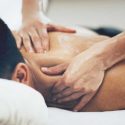Jock Itch Symptoms, Causes and Natural Treatments
If you have ever experienced the irritating, burning sensation of jock itch, you understand how frustrating this condition can be.
While jock itch is most common among athletes who sweat a lot, this skin condition can affect just about anyone.
It is helpful for everyone to know how to prevent this skin disorder from striking, as well as how to treat it, should you succumb.
Like other fungal skin infections, jock itch requires the right conditions to thrive, so preventing those conditions from occurring is critical.
Our guide helps you understand what causes jock itch, how to prevent the condition from forming, and how to treat it naturally.
Because jock itch is so common, especially in men, it is essential to know how to prevent and treat this minor but bothersome condition.
Treating jock itch is relatively simple, and includes proper hygiene and the use of basic, natural products to rid your skin of the fungus that is causing your jock itch symptoms.
Understanding Jock Itch
Tinea cruris is the medical term for the infection that is also known as jock itch, ringworm of the groin, and crotch itch.
This annoying skin condition is caused by a fungal infection, usually from the fungus Trichophyton rubrum.
Other fungi that can contribute to or trigger an outbreak of jock itch include Trichophyton mentagrophytes, Candida albicans, and Epidermophyton floccosum.
Because the fungus that causes jock itch is also responsible for athlete’s foot infections, it is possible to spread this fungus via clothing and contact.
Tinea cruris affects the folds of skin located in the groin area, and can also spread to the thighs and anus.
Because this fungus enjoys warm, moist areas, jock itch is very common in athletes, who often wear sweaty, warm clothing for extended periods, as well as people who are overweight, as they tend to have more folds of skin in which the fungus can grow (1).
Trichophyton fungi cause not only jock itch and athlete’s foot, but also ringworm, nail infections, and other fungal infections of the hair, beard, and scalp.
It is therefore essential that you treat this infection promptly, to prevent spreading the fungus to other parts of your body.
While jock itch is more common in males, who have more folds of skin in their genitals, women can also get this fungal infection.
All this skin condition needs to grow is a warm, moist place.
It is the result of prolonged wetness, friction with clothing, and other conditions that contribute to the growth of the fungal spores.
The fungus that causes jock itch can be passed from person to person, by direct skin contact or touching dirty clothing.
If you have athlete’s foot, and touch your feet and then your groin or another person, you can spread the fungus and possibly trigger an outbreak of jock itch (2).
Other conditions can contribute to the spread of jock itch, including warm, humid weather, having a suppressed immune system, any kind of yeast infection, or being overweight.
If you have any type of immune system problem, you are more likely to develop this fungal infection.
While we all have fungi, bacteria, and other microbes living on our skin, it is when we create the conditions that cause the Trichophyton to thrive that jock itch and other skin fungal infections begin to reproduce rapidly.
The dermatophytes that cause jock itch to consume dead skin cells, which are common in skin folds, and require warm temperatures with plenty of humidity.
These conditions are prevalent both in the male groin and in folds of skin in those who are overweight.
Symptoms of Jock Itch
Jock itch is usually easy to identify from its symptoms, which include (3):
- Itching, burning and chafing affecting the groin, inner thigh, and anal areas
- Red patches of skin that are sometimes scaly or raised. These often have edges that are sharply defined.
- Areas of skin that may have blisters that ooze
- Areas of skin that are abnormally darker or lighter than usual
- Cracking, peeling, or flaking skin
These symptoms usually affect the groin area, but can also include the genitals, thighs, and buttocks.
While uncomfortable and annoying, this condition is rarely serious, and usually clears up with treatment.
Treating Jock Itch Conventionally
Most people can diagnose jock itch for themselves based on the symptoms.
If the signs last for longer than two weeks despite treatment, you may want to consult your doctor; they may want to examine the area or do a skin culture if your infection is severe or does not respond to treatment.
Using basic hygiene practices and making a few changes in your lifestyle, you can usually treat jock itch yourself, without the need for medical attention.
Common recommendations for treating tinea cruris include (4):
- Keeping the area clean and dry. Always use a separate, clean towel to dry the groin area when you have jock itch, to avoid spreading the fungus to other body parts.
- Wearing loose-fitting clothing, and avoiding anything that rubs or irritates the infected skin in this area.
- Showering after physical exercise or profuse sweating of any kind.
- Washing clothing and athletic supporters after each use.
- Changing your underwear and clothing daily.
- Treating any fungal infections on your body, including athlete’s foot, to avoid contamination.
- Avoiding scratching, which can lead to a secondary skin infection.
- Trying natural remedies before resorting to antifungal medications, which can have side effects.
If your skin infection does not improve within a few weeks of making these changes, you may want to consult with your doctor about possible treatments.
There are over-the-counter antifungal medicines available, and most of them contain clotrimazole as their active ingredient.
This drug’s common side effects include skin irritation, redness, stinging, burning, tenderness, swelling, and flaking (5).
Treating Jock Itch Naturally
Natural remedies generally include plants and natural compounds with antifungal properties, and these are just as effective as conventional treatments at eliminating jock itch and other types of fungal skin infections.
Natural remedies are cost-effective, non-toxic, and easily accessible.
They also have fewer side effects, especially for people with sensitive skin or allergies (6).
Make Dietary Changes
The prevention and treatment of jock itch can be supported by changes to your daily intake of certain foods.
Sugars and carbohydrates are known to encourage the growth of different types of fungus, including those responsible for jock itch.
Alcohol also can cause these fungi to grow.
Reducing your consumption of beer, wine, other alcohol, sugar, and carbohydrates can soothe your symptoms and help your body naturally fight fungal skin infections.
Making changes to your diet that include these alterations permanently can prevent an outbreak of jock itch from occurring, in many people.
Apply Cornstarch
Cornstarch is an easy-to-find and inexpensive ingredient with which to treat jock itch.
Cornstarch is a common ingredient in many skin powders, as it absorbs excess moisture, keeping the affected area dry.
Cornstarch also soothes itching, burning skin, preventing further scratching.
Once you have gotten rid of your skin infection, you can use cornstarch to prevent future problems from occurring, as well.
Use Vinegar
Both apple cider and white vinegar have antifungal and antiseptic properties, making them perfect for use in treating jock itch.
Here are a few ways you can apply vinegar to treat this fungal infection:
- Combine equal parts water and apple cider vinegar in a spray bottle. Place this in the refrigerator for a few hours. Spray on the affected area for a cooling effect that also kills the fungus. If you have any secondary skin infection from scratching, the antibacterial properties in apple cider vinegar are also useful for this.
- Apple cider vinegar can also treat any candida yeast infections that may be contributing to your itchiness (7).
- Mix four parts water with one part white vinegar, then soak a clean washcloth in this mixture. Wash the affected area with this cloth, cleaning all the skin folds thoroughly. Allow this area to dry naturally without rinsing. Repeat twice per day until your symptoms subside.
- Combine equal parts of coconut oil and white vinegar. Apply this mixture to the affected area, allowing it to sit for several hours before rinsing. Repeat two times per day until your infection clears.
Take a Soothing Bath
Using oatmeal and Epsom salts in your bath can both help heal your infection and soothe irritated skin.
To your warm bath water, add two cups of colloidal oatmeal and one cup of Epsom salts.
Mix well before entering the bath, then soak for up to 20 minutes.
Use warm, not hot water, as hot water can further irritate itchy skin.
You can add some relaxing essential oils, such as lavender or chamomile, to your bath water, as well.
Eat More Probiotics
Probiotics are the natural, helpful bacteria in your body that keep invading microbes, like fungi and yeast cells, under control.
When your body naturally has plenty of probiotics, it is better able to fight infections like jock itch.
To increase your store of healthy bacteria, eat more foods naturally high in probiotics, like yogurt with active cultures, sauerkraut, kombucha, kimchi, kefir, and other fermented foods.
You can also take a probiotic supplement to increase your healthy bacteria levels.
Probiotics should be used in conjunction with topical or external treatments for treating jock itch.
To prevent future problems with jock itch and other skin infections, add probiotics to your diet on a regular basis, and maintain a healthy balance of helpful bacteria in your gut.
This will help you fight off all types of infections.
Use Coconut Oil
A natural antifungal, coconut oil is perfect for treating jock itch.
The soothing properties of coconut oil can treat irritated skin, while the oil also prevents the spread of skin infection by inhibiting the growth of fungal cells.
Coconut oil relieves the symptoms of jock itch, including itching, redness, irritation, and scaly skin.
To use this treatment, apply coconut oil to the affected area using a clean, dry cotton ball after you have showered or thoroughly cleaned the skin.
Allow the oil to absorb fully into the skin, and repeat the application at least three times per day until the infection is cleared.
Use Honey and Garlic
As a natural antiseptic, garlic is an excellent choice for treating jock itch.
When it is combined with honey, which naturally soothes skin, they make a great combination.
Garlic is naturally high in sulfides, including disulfides, trisulfides, and monosulfides, some of which are antifungal compounds (8).
Applying garlic alone would irritate the skin, but when combined with honey, it becomes a soothing, moisturizing treatment that kills the fungus.
For an effective treatment, mince two cloves of garlic, then combine with two tablespoons of unfiltered, raw honey.
Add enough warm water to create a paste, then apply this to the affected area twice a day for 15 minutes.
Rinse the area thoroughly after each application, allowing it to dry thoroughly before redressing.
Increasing your consumption of garlic can also help prevent future infections.
And taking garlic capsules may help treat an active infection.
Try Onion
Like garlic, onions are rich in natural sulfides, giving them antibacterial, antifungal, and anti-inflammatory properties.
Onions can be useful in the treatment of jock itch and other fungal skin infections.
To use, puree one onion into a paste, then apply this to the affected area and let sit for 30 minutes.
Rinse thoroughly, and allow to dry naturally.
Repeat twice per day until the infection clears.
You can also use onion oil, which is available in health food stores.
Apply Calendula
Made from calendula flowers, also known as marigolds, calendula oil or tincture is an excellent treatment for those with sensitive skin who are experiencing a fungal skin infection like jock itch.
Marigold has natural skin-healing properties, so they calm and soothe the irritated skin (9).
Calendula can be applied regularly to the affected area until symptoms disappear.
Drink Chamomile Tea
Chamomile tea isn’t just for helping you sleep.
The natural and gentle properties of chamomile also soothe skin and ease irritation.
Drinking chamomile can help heal skin and promote repair of damaged tissue.
You can also apply wet chamomile tea bags directly to the affected area to relieve itching, irritation, and redness.
Steep a tea bag to make a cup of tea, then apply the cooled bag to your skin while you drink the tea.
You will be healing your jock itch from the inside and outside at the same time!
Use Lavender or Tea Tree Oil
Lavender, in addition to acting as a natural calming agent, also has antiseptic and antifungal properties.
Lavender essential oil can help heal wounds and prevent the formation of scars, and because it is gentle, it is safe to use with children and those with sensitive skin.
Using lavender essential oil on skin irritated by jock itch can stop the progression of the fungal infection while promoting healing and easing symptoms (10).
Tea tree essential oil is another topical treatment for jock itch and has natural antifungal properties.
Tea tree oil is a natural antiseptic that is also often used to treat fungal nail infections.
It can reduce inflammation and itching, and naturally kills fungus (11).
To use, combine several drops of tea tree essential oil with one ounce of a carrier oil, such as coconut or olive.
Apply to the affected area, allowing the mixture to soak in.
Reapply several times a day until your infection clears.
Use Aloe Vera
Aloe vera gel has been used for centuries to treat skin infections and irritation.
As a natural antimicrobial substance, aloe vera can also reduce symptoms of jock itch, and comfort and soothe the skin.
Because it can penetrate below the outer layer of skin, it can heal more deeply and provide relief faster.
The glycoprotein found in aloe vera gel reduces pain and inflammation and can ease itchiness, all while killing the infection that causes tinea cruris.
Preventing Jock Itch
If you want to be sure you never get jock itch, or you want to prevent future infection once you have recovered, there are many steps you can take to avoid the perpetuation of the conditions that support this fungal growth.
Most of these have to do with your hygiene and will help you prevent the growth and spread of fungal spores that cause jock itch.
These practices are a good idea even if you currently have an infection.
To prevent the formation and spread of tinea cruris, you should:
- Bathe daily. If you play sports or are very physically active, always shower after sweating for extended periods.
- Keep your groin area as dry as possible. Use powder to absorb excess moisture between showers.
- Use a clean towel after each shower, and never share a towel with anyone else.
- Do not wear wet or sweaty clothing for extended periods. This includes bathing suits.
- Wear loose-fitting clothing, and avoid tight undergarments.
- Wash jock straps and all athletic clothing regularly.
- Wear clean underwear each day. Change your clothes regularly.
- Avoid spreading fungal infections from other parts of your body to your groin. Treat fungal infections such as ringworm and athlete’s foot immediately, and avoid touching these areas with your hands or clothing.
- If you have athlete’s foot, put your socks on before your underwear to prevent the spread of fungus to your groin.
- Never touch or scratch your groin after touching other areas of your body.
- If you have jock itch currently, use a separate towel from that used for the rest of your body to dry your groin area.
If you are obese, work toward making healthier choices that allow you to lose weight.
Excess weight creates folds of skin that become home to fungus, making it hard to treat and cure an infection.
Losing weight is essential to preventing future infections.
Conclusion
Jock itch is a type of fungal skin infection common in men, those who are obese, and athletes.
The fungus that causes jock itch thrives in warm, moist environments such as those found in the groin area.
To prevent the onset of this type of infection, you should keep the area clean and dry, which will limit opportunities for the fungus to grow.
When treating jock itch using over-the-counter or natural remedies, you should discontinue treatment if you notice a worsening of the irritation or a rash that looks different.
If you have other medical conditions, exercise caution when treating this infection on your own.
If you take prescription medications, talk with your doctor about how these may be contributing to your infection or interfering with treatment.
Essential oils should be used with caution on your skin.
Always test a small patch of less-sensitive skin first to be sure you do not react to the oils, and always dilute strong oils with a carrier oil appropriate for skin application.
Jock itch is usually a minor annoyance but can be quite irritating, which is why most sufferers would like it cured quickly.
Preventing the conditions that support fungal growth is key, as is using antifungal compounds and ingredients to treat the infection.
Whether you use over-the-counter or natural remedies, observe your symptoms carefully, and report any abnormalities to your doctor.
Preventing jock itch is possible using good hygiene and common sense practices.
Washing yourself and your clothes regularly are essential, as is keeping your groin area as dry as possible.
If you do find yourself experiencing jock itch, try using one of the natural remedies discussed here, including changing your diet, applying essential oils or vinegar, eating more probiotics, drinking chamomile tea, applying onions or garlic, using aloe vera, or taking a soothing bath.
FDA Compliance
The information on this website has not been evaluated by the Food & Drug Administration or any other medical body. We do not aim to diagnose, treat, cure or prevent any illness or disease. Information is shared for educational purposes only. You must consult your doctor before acting on any content on this website, especially if you are pregnant, nursing, taking medication, or have a medical condition.
HOW WOULD YOU RATE THIS ARTICLE?






